Simulations of Ozone Feedback Effects on the Equatorial Quasi-Biennial Oscillation with a Chemistry–Climate Model
Abstract
1. Introduction
2. Model and Simulations
3. Results
3.1. Zonal Wind and Temperature
3.2. Vertical Veocity, Ozone and Radiative Heating
3.3. Latitudinal Extent of the Meridional Circulation
4. Discussion
5. Conclusions
Funding
Informed Consent Statement
Data Availability Statement
Acknowledgments
Conflicts of Interest
References
- Dall’Amico, M.; Gray, L.J.; Rosenlof, K.H.; Scaife, A.A.; Shine, K.P.; Stott, P.A. Stratospheric temperature trends: Impact of ozone variability and the QBO. Clim. Dyn. 2010, 34, 381–398. [Google Scholar] [CrossRef]
- Bushell, A.C.; Jackson, D.R.; Butchart, N.; Hardiman, S.C.; Hinton, T.J.; Osprey, S.M.; Gray, L.J. Sensitivity of GCM tropical middle atmosphere variability and climate to ozone and parameterized gravity wave changes. J. Geophys. Res. 2010, 115, D15101. [Google Scholar] [CrossRef]
- Eyring, V.; Butchart, N.; Waugh, D.W.; Akiyoshi, H.; Austin, J.; Bekki, S.; Bodeker, G.E.; Boville, B.A.; Brühl, C.; Chipperfield, M.P.; et al. Assessment of temperature, trace species and ozone in chemistry-climate model simulations of the recent past. J. Geophys. Res. 2006, 111, D22308. [Google Scholar] [CrossRef]
- Eyring, V.; Cionni, I.; Bodeker, G.E.; Charlton-Perez, A.J.; Kinnison, D.E.; Scinocca, J.F.; Waugh, D.W.; Akiyoshi, H.; Bekki, S.; Chipperfield, M.P.; et al. Multi-model assessment of stratospheric ozone return dates and ozone recovery in CCMVal-2 models. Atmos. Chem. Phys. 2010, 10, 9451–9472. [Google Scholar] [CrossRef]
- Ebdon, R.A.; Veryard, R.G. Fluctuations in equatorial stratospheric winds. Nature 1961, 189, 791–793. [Google Scholar] [CrossRef]
- Reed, R.J.; Campbell, W.J.; Rasmussen, L.A.; Rogers, D.G. Evidence of a downward-propagating, annual wind reversal in the equatorial stratosphere. J. Geophys. Res. 1961, 66, 813–818. [Google Scholar] [CrossRef]
- Funk, J.P.; Garnham, G.L. Australian ozone observations and a suggested 24 month cycle. Tellus 1962, 14, 378–382. [Google Scholar] [CrossRef]
- Ramanathan, K.R. Bi-annual variation of atmospheric ozone over the tropics. Q. J. R. Meteorol. Soc. 1963, 89, 540–542. [Google Scholar] [CrossRef]
- Lindzen, R.S.; Holton, J.R. A theory of quasi-biennial oscillation. J. Atmos. Sci. 1968, 25, 1095–1107. [Google Scholar] [CrossRef]
- Holton, J.R.; Lindzen, R.S. An updated theory for the quasi-biennial cycle of the tropical stratosphere. J. Atmos. Sci. 1972, 29, 1076–1080. [Google Scholar] [CrossRef]
- Plumb, R.A.; Bell, R.C. A model of the quasi-biennial oscillation on an equatorial beta-plane. Q. J. R. Meteorol. Soc. 1982, 108, 335–352. [Google Scholar] [CrossRef]
- Dunkerton, T.J. A two-dimensional model of the quasi-biennial oscillation. J. Atmos. Sci. 1985, 42, 1151–1160. [Google Scholar] [CrossRef]
- Hasebe, F. Quasi-biennial oscillations of ozone and diabatic circulation in the equatorial stratosphere. J. Atmos. Sci. 1994, 51, 729–745. [Google Scholar] [CrossRef][Green Version]
- Li, D.; Shine, K.P.; Gray, L.J. The role of ozone-induced diabatic heating anomalies in the quasi-biennial oscillation. Q. J. R. Meteorol. Soc. 1995, 121, 937–943. [Google Scholar] [CrossRef]
- Cordero, E.C.; Nathan, T.R. The influence of wave- and zonal mean-ozone feedbacks on the quasi-biennial oscillation. J. Atmos. Sci. 2000, 57, 3426–3442. [Google Scholar] [CrossRef]
- Huang, T.Y.W. The impact of solar radiation on the quasi-biennial oscillation of ozone in the tropical stratosphere. Geophys. Res. Lett. 1996, 23, 3211–3214. [Google Scholar] [CrossRef]
- Tanii, R.; Hasebe, F. Ozone feedback stabilizes the quasi-biennial oscillation against volcanic perturbations. Geophys. Res. Lett. 2002, 29, 1110. [Google Scholar] [CrossRef]
- Butchart, N.; Scaife, A.A.; Austin, J.; Hare, S.H.E.; Knight, J.R. Quasi-biennial oscillation in ozone in a coupled chemistry-climate model. J. Geophys. Res. 2003, 108, 4486. [Google Scholar] [CrossRef]
- Shibata, K.; Deushi, M. Radiative effect of ozone on the quasi-biennial oscillation in the equatorial stratosphere. Geophys. Res. Lett. 2005, 32, L24802. [Google Scholar] [CrossRef]
- Tian, W.; Chipperfield, M.P.; Gray, L.J.; Zawodny, J.M. Quasi-biennial oscillation and tracer distributions in a coupled chemistry-climate model. J. Geophys. Res. 2006, 111, D20301. [Google Scholar] [CrossRef]
- Shibata, K.; Lehmann, R. Partitioning of ozone loss pathways in the ozone quasi-biennial oscillation simulated by a chemistry-climate model. J. Meteorol. Soc. Jpn. 2020, 98, 615–636. [Google Scholar] [CrossRef]
- Shibata, K.; Deushi, M. Simulation of the stratospheric circulation and ozone during the recent past (1980–2004) with the MRI chemistry-climate model. In CGER’s Supercomputer Monograph Report; National Institute for Environmental Studies: Tsukuba, Japan, 2008; Volume 13, 154p. [Google Scholar]
- Hines, C.O. Doppler-spread parameterization of gravity-wave momentum deposition in the middle atmosphere. Part 2: Broad and quasi monochromatic spectra, and implementation. J. Atmos. Sol.-Terr. Phys. 1997, 59, 387–400. [Google Scholar] [CrossRef]
- Morgenstern, O.; Giorgetta, M.; Shibata, K. Chemistry Climate Models and Scenarios. 2010. Available online: https://library.wmo.int/index.php?lvl=notice_display&id=17#.YP0YRDpUuhd (accessed on 25 May 2021).
- Uppala, S.M.; Kållberg, P.W.; Simmons, A.J.; Andrae, U.; da Costa Bechtold, V.; Fiorino, M.; Gibson, J.K.; Haseler, J.; Hernandez, A.; Kelly, G.A.; et al. The ERA-40 Reanalysis. Quart. J. Roy. Meteorol. Soc. 2005, 131, 2961–3012. [Google Scholar] [CrossRef]
- Newman, P.A.; Coy, L.; Pawson, S.; Lait, L.R. The anomalous change in the QBO in 2015–2016. Geophys. Res. Lett. 2016, 43, 8791–8797. [Google Scholar] [CrossRef]
- Andrews, D.G.; Holton, J.R.; Leovy, C.B. Middle Atmosphere Dynamics; Academic Press: Orland, CA, USA, 1987; pp. 314–319. [Google Scholar]
- Randel, W.J.; Wu, F.; Swinbank, R.; Nash, J.; O’Neill, A. Global QBO circulation derived from UKMO stratospheric analyses. J. Atmos. Sci. 1999, 56, 457–474. [Google Scholar] [CrossRef]
- Niwano, M.; Shiotani, M. Quasi-biennial oscillation in vertical velocity inferred from trace gas data in the equatorial lower stratosphere. J. Geophys. Res. 2001, 106, 7281–7290. [Google Scholar] [CrossRef]
- Zawodny, J.M.; McCormick, M.P. Stratospheric aerosol and gas experiment II: Measurements of the quasi-biennial oscillation in ozone and nitrogen dioxide. J. Geophys. Res. 1991, 96, 9371–9377. [Google Scholar] [CrossRef]
- Chipperfield, M.P.; Gray, L.J.; Kinnersley, J.S.; Zawodny, J. A two-dimensional model study of the QBO signal in SAGE II NO2 and O3. Geophys. Res. Lett. 1994, 21, 589–592. [Google Scholar] [CrossRef]
- Hauchecorne, A.; Bertaux, J.L.; Dalaudier, F.; Keckhut, P.; Lemennais, P.; Bekki, S.; Marchand, M.; Lebrun, J.C.; Kyrölä, E.; Tamminen, J.; et al. Response of tropical stratospheric O3, NO2 and NO3 to the equatorial Quasi-Biennial Oscillation and to temperature as seen from GOMOS/ENVISAT. Atmos. Chem. Phys. 2010, 10, 8873–8879. [Google Scholar] [CrossRef]
- Shibata, K.; Deushi, M. Partitioning between resolved wave forcing and unresolved gravity wave forcing to the quasi-biennial oscillation as revealed with a coupled chemistry-climate model. Geophys. Res. Lett. 2005, 32, L12820. [Google Scholar] [CrossRef]
- Duchon, C.E. Lanczos filtering in one and two dimensions. J. Appl. Meteorol. 1979, 18, 1016–1022. [Google Scholar] [CrossRef]
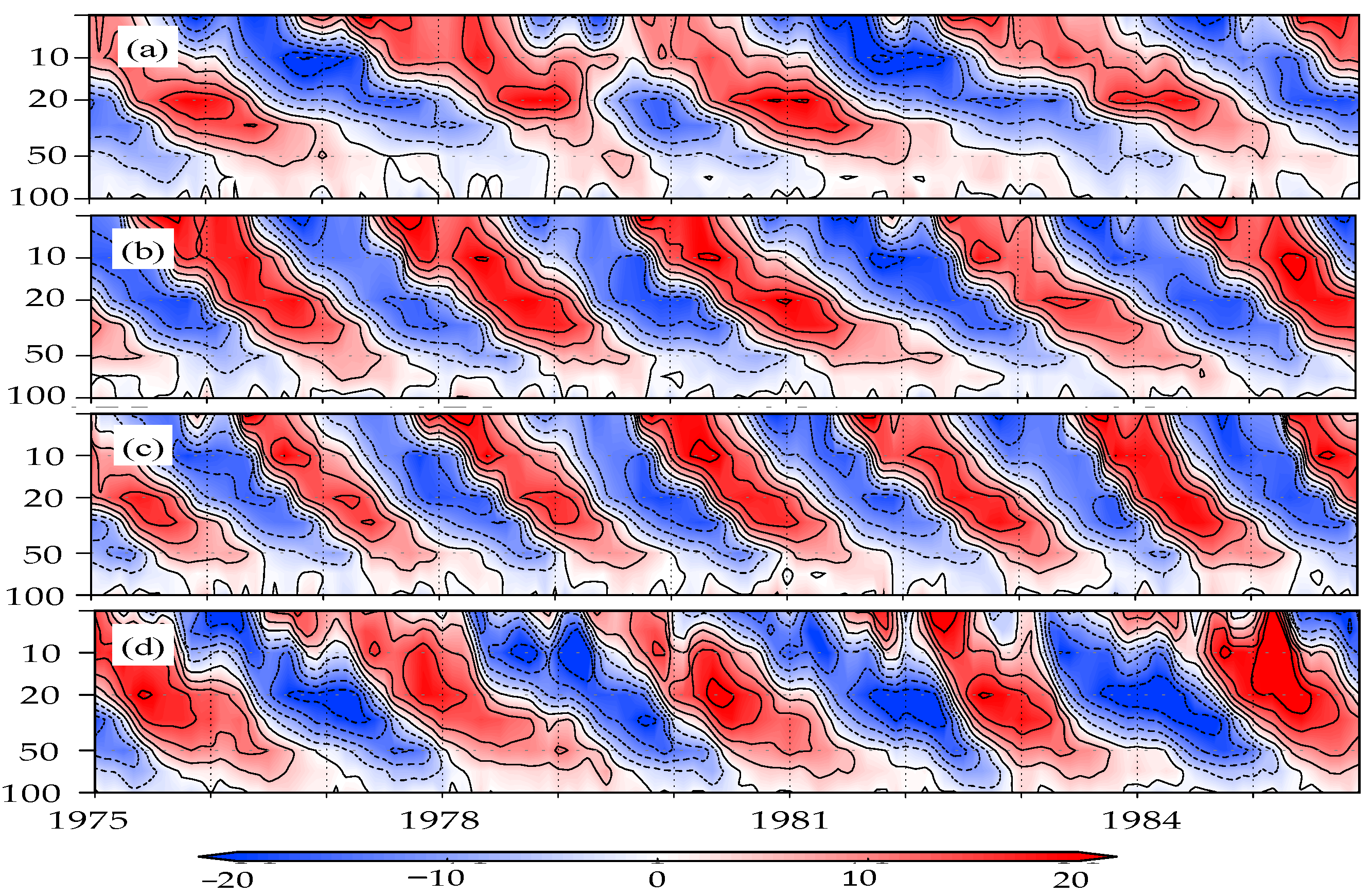
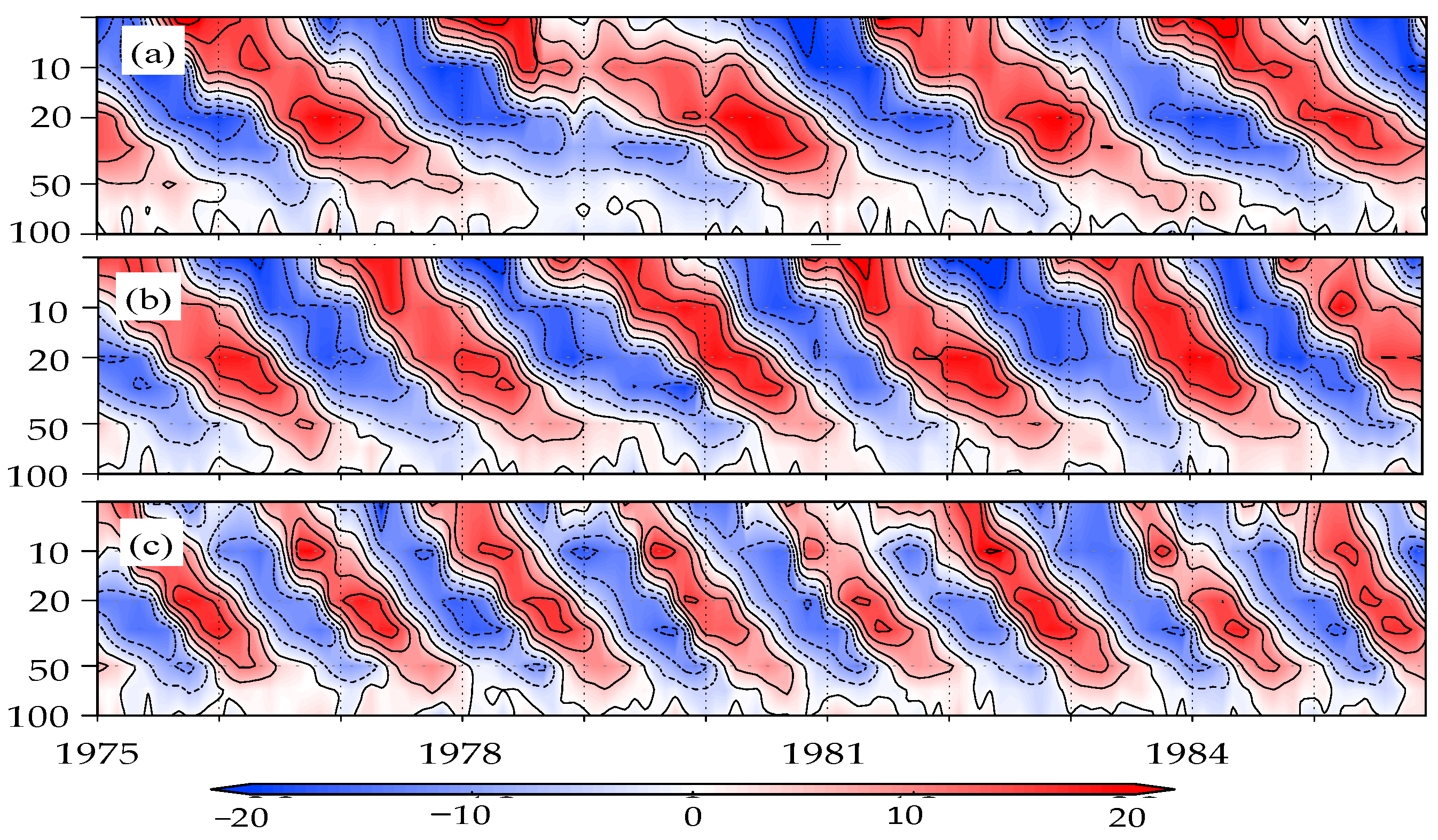
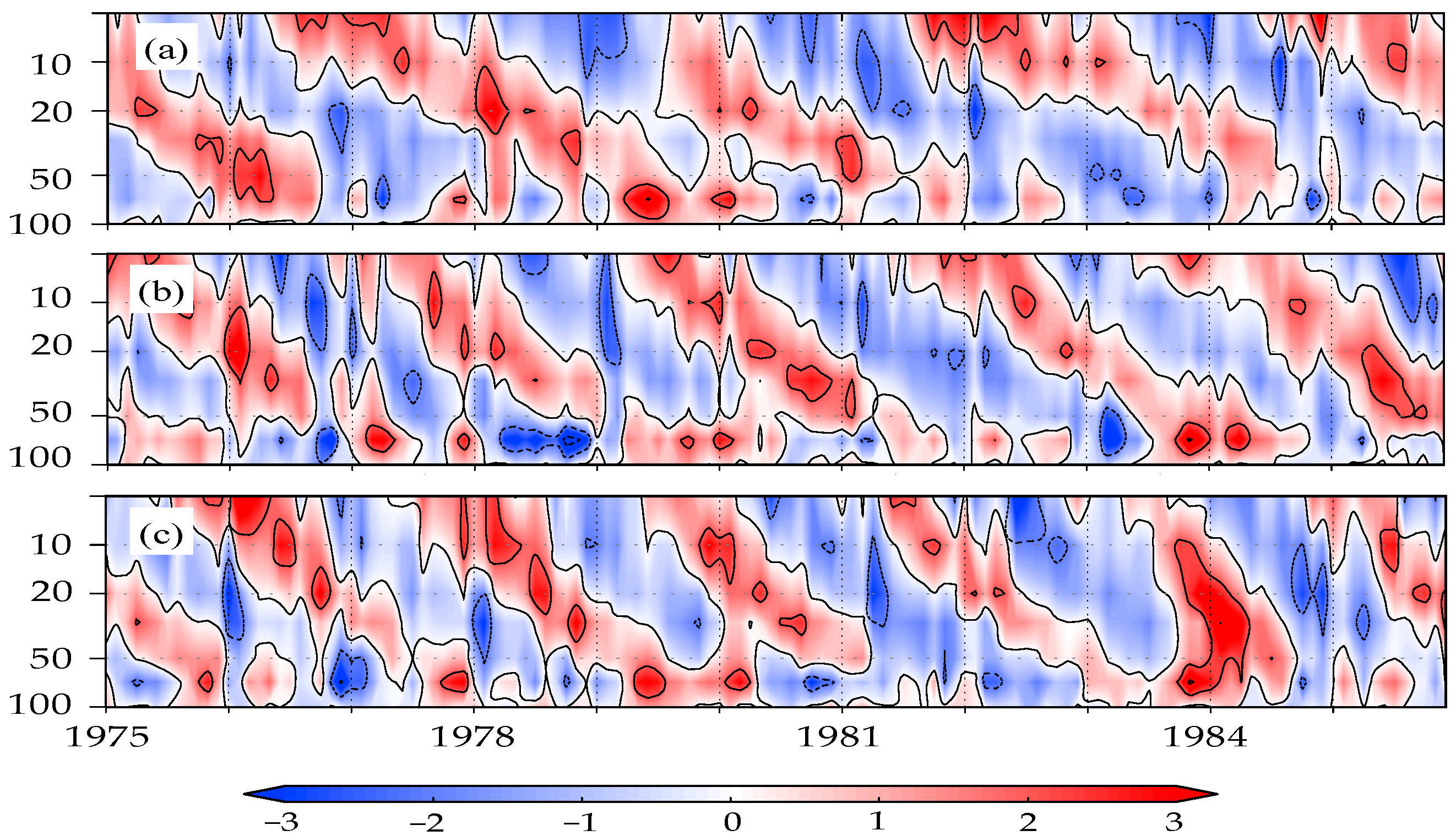
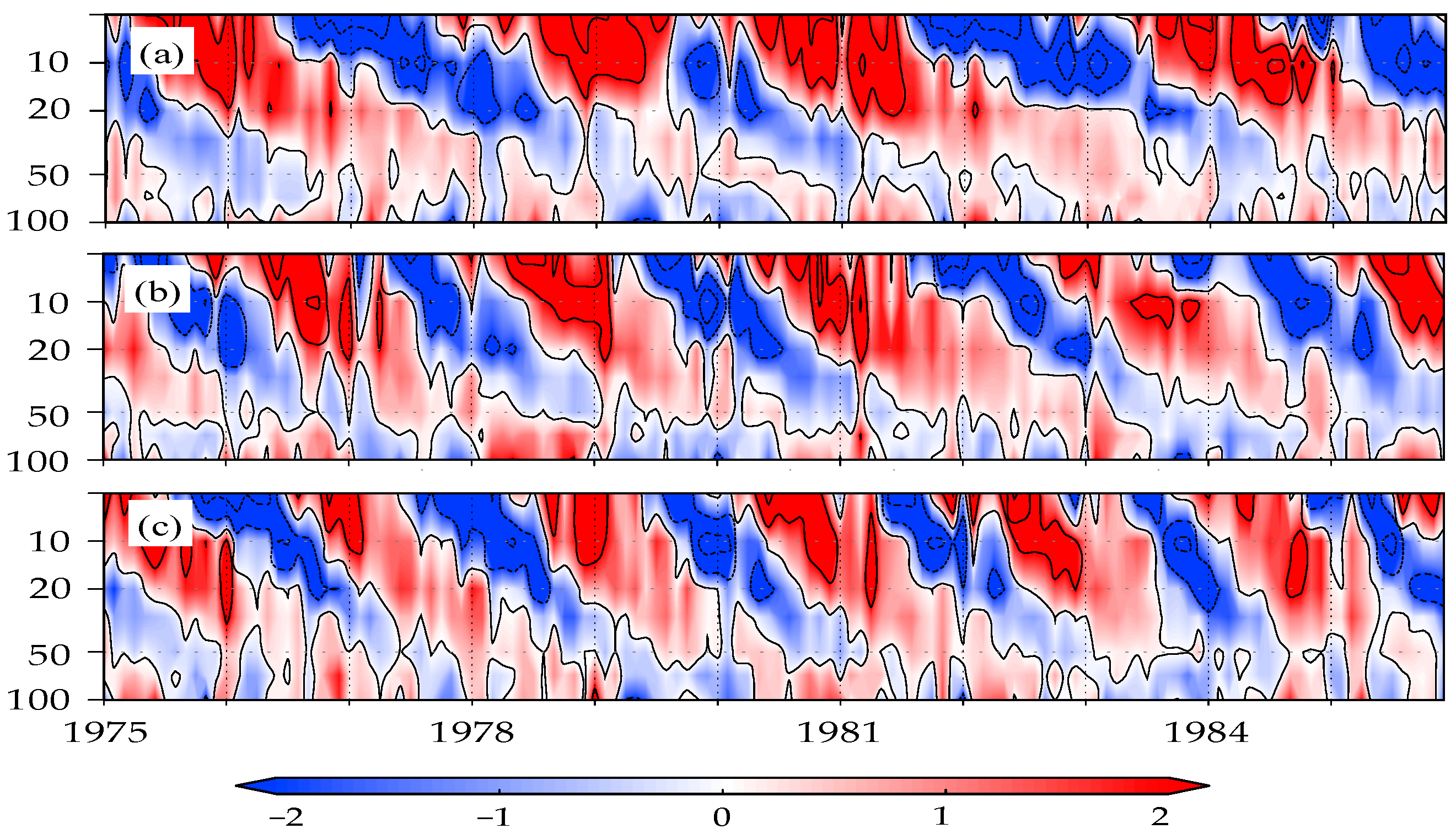


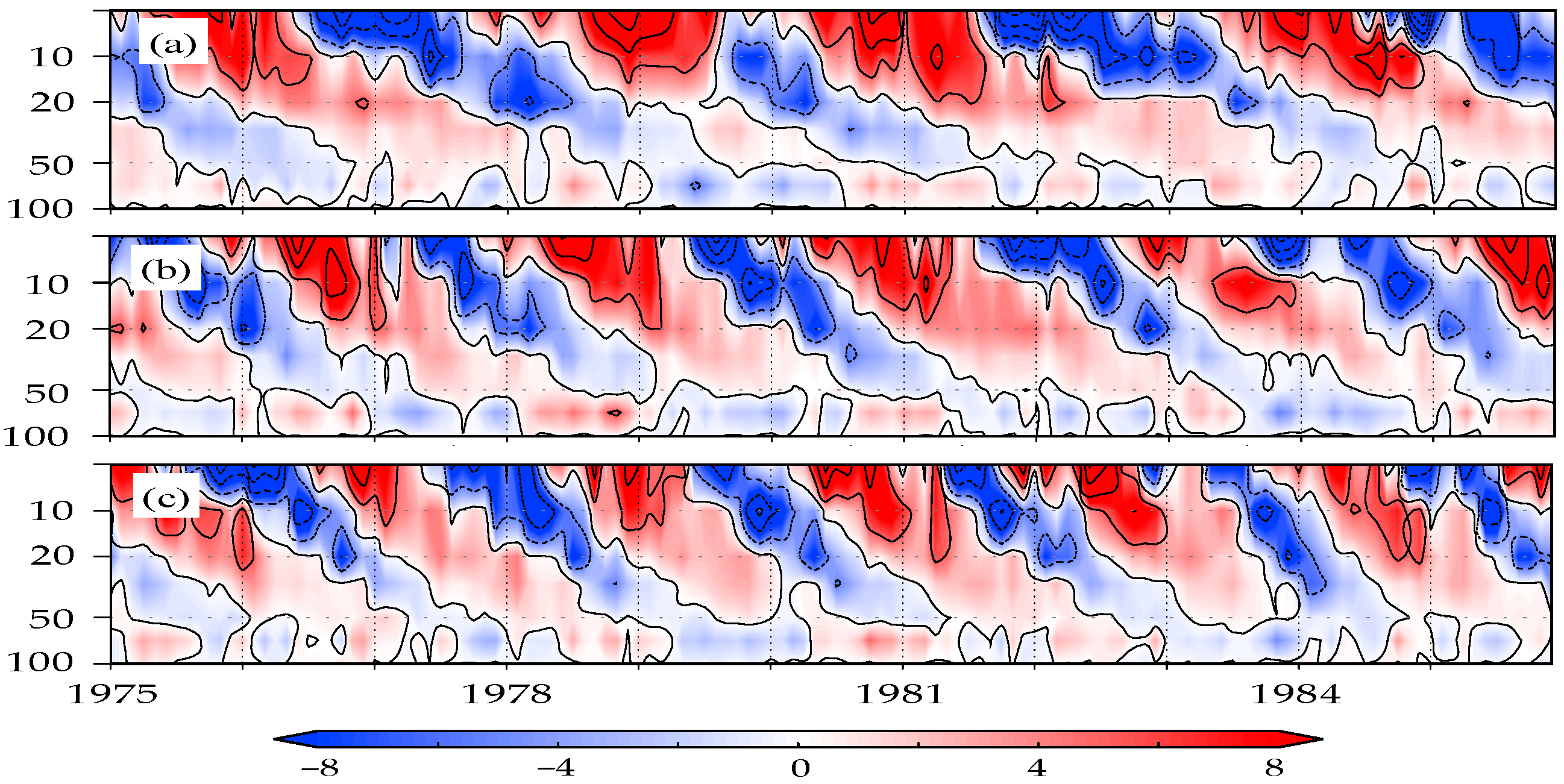

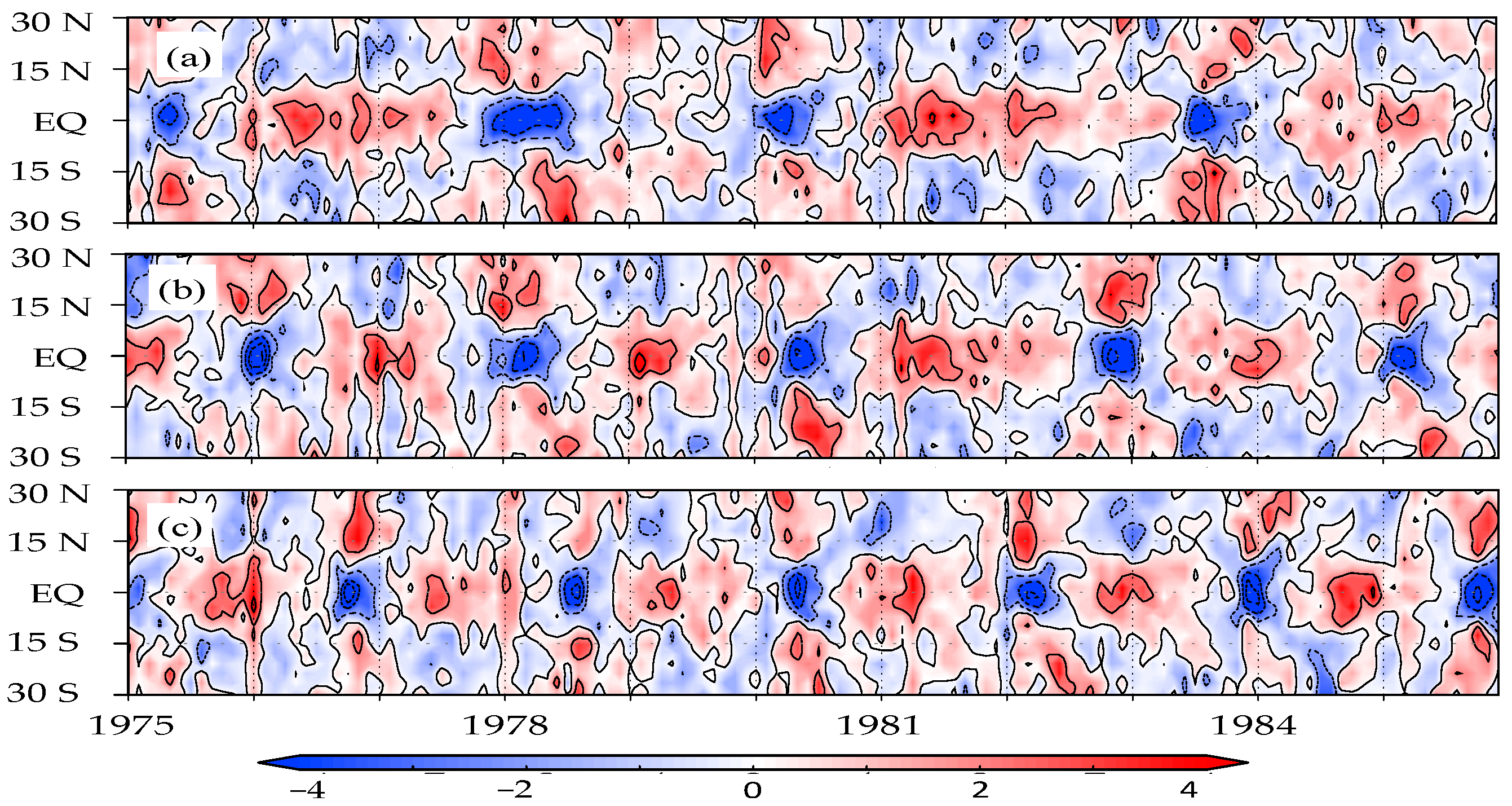

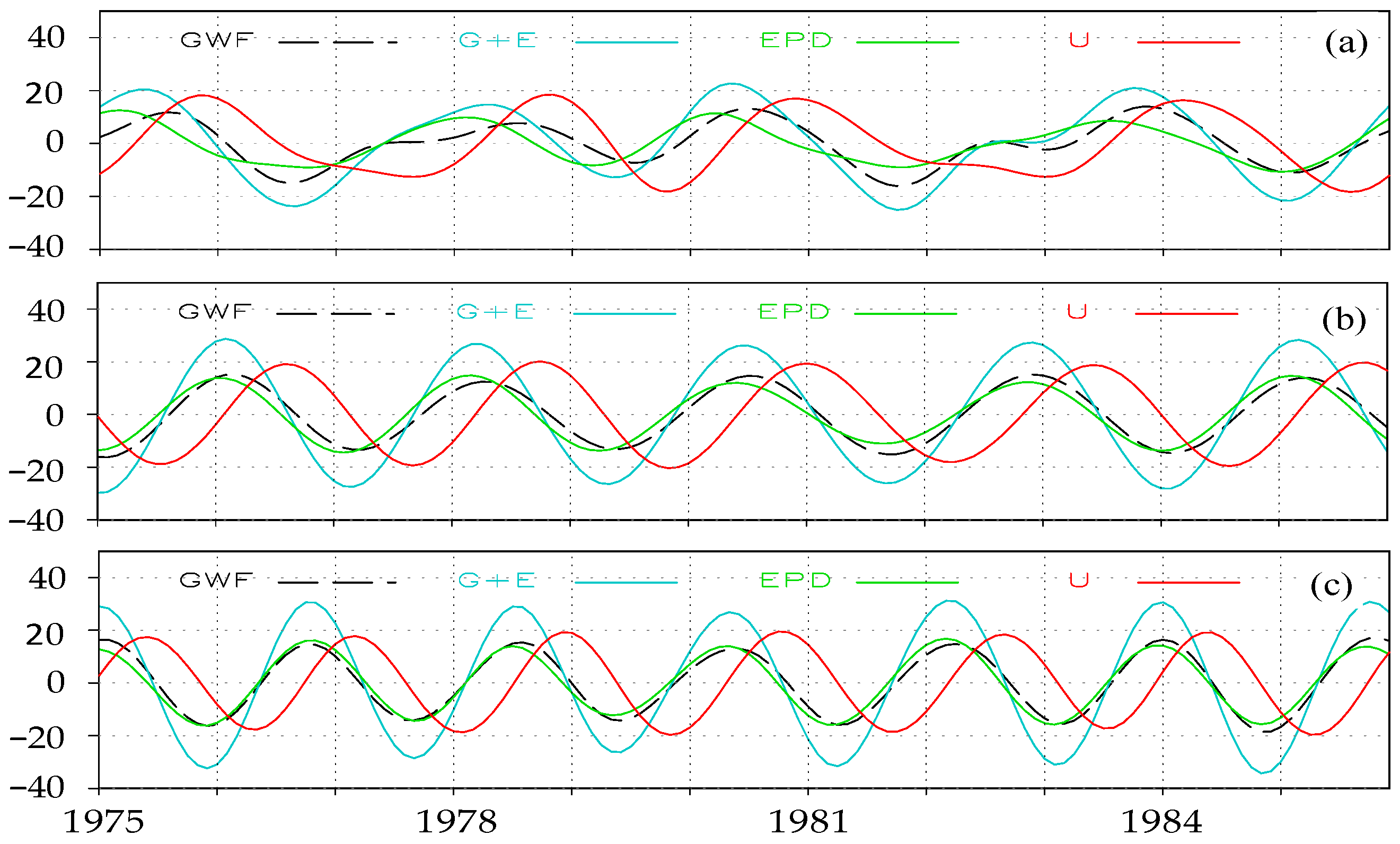
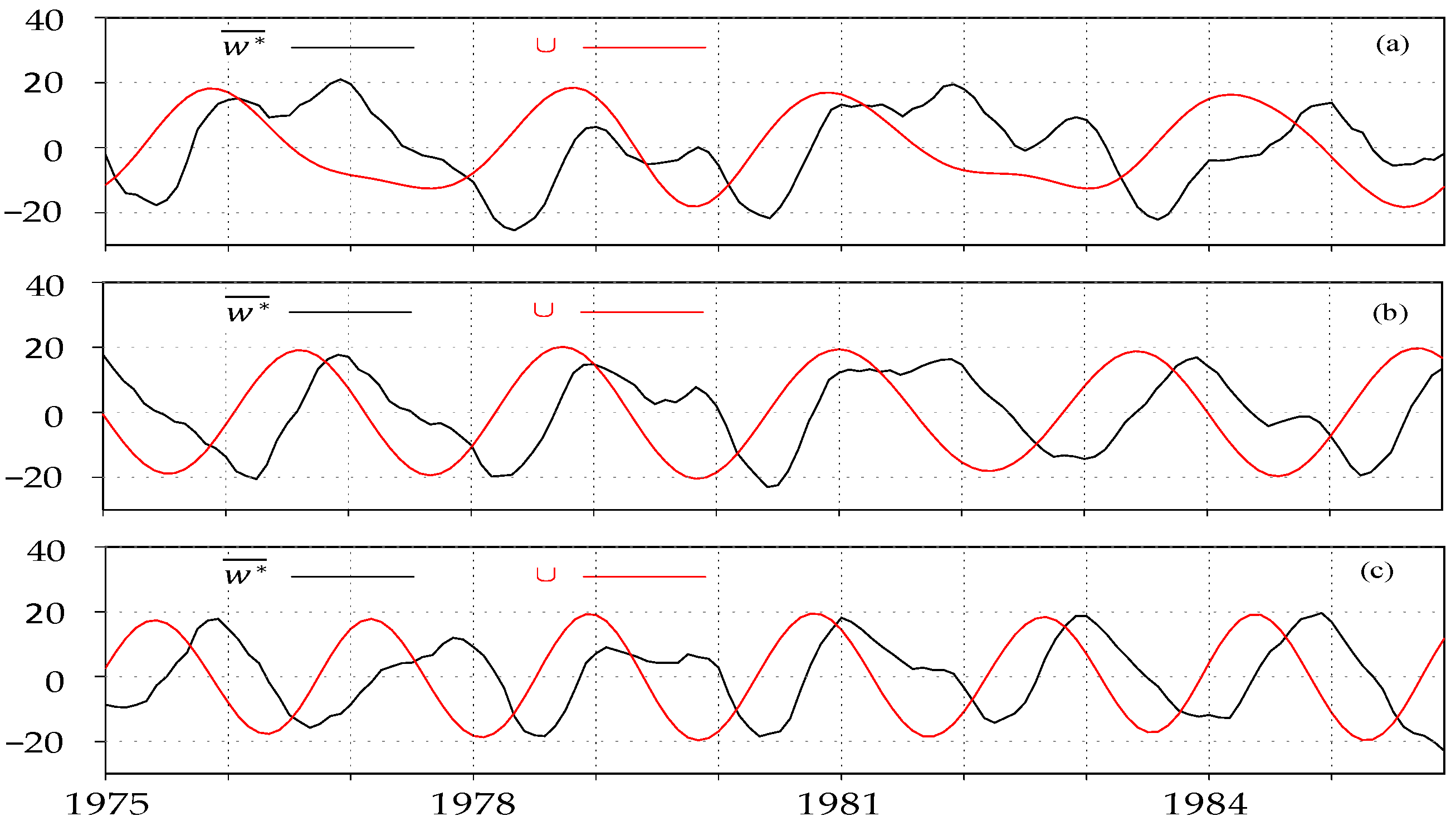
| Altitude (hPa) | P(+20%) | Q(+10%) | ST(0%) | M(−10%) | N(−20%) | L(−40%) |
|---|---|---|---|---|---|---|
| 10 | 62 ± 13 | 57 ± 13 | 51 ± 9 | 42 ± 10 | 39 ± 7 | 20 ± 2 |
| 20 | 41 ± 9 | 39 ± 10 | 36 ± 7 | 33 ± 9 | 29 ± 6 | 19 ± 4 |
| 30 | 36 ± 4 | 33 ± 4 | 30 ± 5 | 28 ± 4 | 25 ± 3 | 18 ± 2 |
| P(+20%) | Q(+10%) | ST(0%) | M(−10%) | N(−20%) | L(−40%) | |
|---|---|---|---|---|---|---|
| τ(mon) | 34 | 31 | 28 | 22 | 21 | 17 |
| u(ms−1) | 16 | 16 | 18 | 19 | 18 | 12 |
| T(°C) | 1.4 | 1.2 | 1.5 | 1.6 | 1.7 | 1.1 |
| O3(10 hPa) | 0.23 | 0.28 | 0.26 | 0.24 | 0.21 | 0.08 |
| O3(20 hPa) | 0.19 | 0.19 | 0.20 | 0.17 | 0.16 | 0.07 |
| O3(30 hPa) | 0.28 | 0.27 | 0.29 | 0.36 | 0.35 | 0.26 |
Publisher’s Note: MDPI stays neutral with regard to jurisdictional claims in published maps and institutional affiliations. |
© 2021 by the author. Licensee MDPI, Basel, Switzerland. This article is an open access article distributed under the terms and conditions of the Creative Commons Attribution (CC BY) license (https://creativecommons.org/licenses/by/4.0/).
Share and Cite
Shibata, K. Simulations of Ozone Feedback Effects on the Equatorial Quasi-Biennial Oscillation with a Chemistry–Climate Model. Climate 2021, 9, 123. https://doi.org/10.3390/cli9080123
Shibata K. Simulations of Ozone Feedback Effects on the Equatorial Quasi-Biennial Oscillation with a Chemistry–Climate Model. Climate. 2021; 9(8):123. https://doi.org/10.3390/cli9080123
Chicago/Turabian StyleShibata, Kiyotaka. 2021. "Simulations of Ozone Feedback Effects on the Equatorial Quasi-Biennial Oscillation with a Chemistry–Climate Model" Climate 9, no. 8: 123. https://doi.org/10.3390/cli9080123
APA StyleShibata, K. (2021). Simulations of Ozone Feedback Effects on the Equatorial Quasi-Biennial Oscillation with a Chemistry–Climate Model. Climate, 9(8), 123. https://doi.org/10.3390/cli9080123





